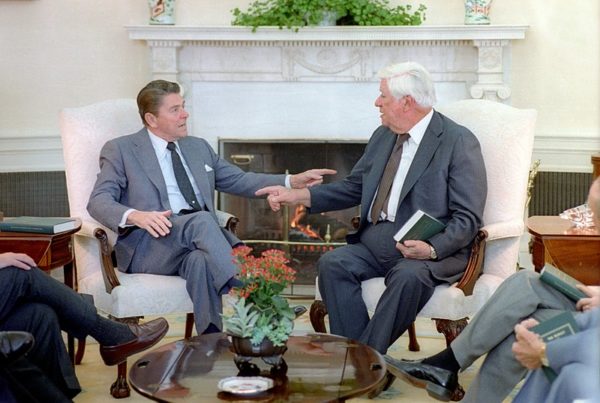On the early American frontier, neighbors recognized the value in helping each other move their timber to a river for transporting or to a homestead for burning or cabin construction. The end result was the same as if each person had labored alone, but the sum total of all the effort needed was less. Put another way, this particular form of social organization maximized the cooperative surplus generated by the community’s total efforts and everyone was made better off, sharing in that surplus.
Davy Crockett, the frontiersman turned U.S. congressman, is credited with being the first person to borrow the term logrolling from the frontier and use it to describe the process of legislators helping each other by trading votes. By pledging a vote on an issue of lesser concern in return for a colleague’s vote on an issue of greater concern, two legislators can obtain more total utility than if each were to vote [their] preference on both matters. The practice continues to be common in politics, whether lawmakers are trading votes across different pieces of legislation or across features within a single piece of legislation.
In this way, President Ronald Reagan, who wanted to cut Social Security benefits, and Democratic Speaker of the House Tip O’Neill, who wanted to expand that program’s scope, famously reached agreement on legislation to improve the financial stability of the Social Security Trust Fund in 1983. Reagan secured O’Neill’s support for reducing annual cost-of-living increases in return for Reagan’s agreeing to require government employees to join the system and to tax a portion of the benefits paid to high earners. Reagan signed the resulting bill into law after it passed both the Democratic House and the Republican Senate.

President Reagan with Thomas “Tip” O’Neil during a meeting with a group of Bipartisan Congressional Leaders to discuss the 1984 Budget in the Oval Office, 1/31/1983. Source: National Archives Catalog.
Three years later, the same two adversaries reached agreement on the Tax Reform Act of 1986. O’Neill agreed to Reagan’s demand that the highest marginal tax rate be reduced to 28 percent in return for the president’s acceptance of equalizing the tax rate on capital gains and earned income so that the investor class would not pay a lower rate than the working class.
You don’t have to look to Capitol Hill to see logrolling in action; it is a fundamental principle of Deal Design in a wide range of negotiating situations. The opportunity for logrolling nearly always arises whenever a negotiation includes multiple issues, which all complex negotiations do. The parties usually have different preferences, different available resources or talents, or different tastes for risk, all of which suggest the opportunity to increase the cooperative surplus of an agreement by trading concessions across issues.
In 1977, movie director and producer George Lucas was looking to cast what he was then calling his “space opera,” which eventually became known as Star Wars. His available budget didn’t match his grand ambitions, which forced him to cast many lesser-known actors in key roles— some of whom, of course, went on to become quite famous. For the role of Obi-Wan Kenobi, however, Lucas wouldn’t compromise: he wanted Academy Award–winning actor Sir Alec Guinness for the part. Of course, Guinness preferred a substantial up-front fee, but his comfortable financial position made him open to taking a risk on the success of a new movie concept and an unknown filmmaker. So, Guinness agreed to take a lower-than-usual salary in return for 2 percent of the gross royalties earned by Lucas, creating a bargaining zone and making a deal possible (and, as it turned out, making Guinness tens of millions of dollars in the long run).

Logrolling enabled George Lucas to cast Sir Alec Guinness as Obi-wan Kenobi in the original “Star Wars”. Photo by iam_os on Unsplash.
As obvious as logrolling is as a potentially valuable negotiation tactic, and as common as it is in virtually all types of negotiations, several psychological barriers can impede its successful use, leaving negotiators with agreements that are less beneficial to both parties. Logrolling requires one party to propose a concession that is less important to [them] than to [their] counterpart. Reactive devaluation (Chapter 18), the psychological tendency to want something less if it is available, threatens to cause negotiators to be less enamored of concessions once these are offered than if the concessions were analyzed in the abstract. And because negotiators are likely to use the customary deal structure as the reference point against which they evaluate Deal Design proposals, loss aversion (Chapter 14) can cause the potential sacrifice that is a necessary aspect of logrolling to loom larger than the offsetting benefit.
Another impediment, labeled the fixed-pie bias by psychologists Max Bazerman and Margaret Neale, causes people to assume, without exploration, that their counterpart will value issues in the same way and to the same extent that they do. In a negotiation simulation that I conduct in classes and workshops, one negotiator plays the role of a movie-studio executive and another a star actor’s agent in a movie-contract negotiation. One of many issues they need to resolve is whether the studio or the actor will have control over the choice of director for the film. The negotiators can resolve this issue by allocating control to either party or agreeing to “joint control” (in which case both sides have veto power and must agree on a director). The way the simulation is written, the actor is very particular about his directors, and he would greatly prefer to have sole control. The studio would also prefer to have director control, but its preference is weak—that is, it has only a slight preference for sole control compared to either joint control or actor control—because it has confidence in the star’s judgment.
Quite often, the actor’s agent assumes, incorrectly as it turns out, that since his client has a strong preference for selecting the director, the studio must also have a strong preference. When this happens, the parties often agree to the apparent compromise solution of joint control. But the deal can create more cooperative surplus, and both parties can individually enjoy more utility, if they allocate director control to the actor, who cares more about the issue, and logroll that issue in return for a concession on another issue or issues in which the studio has a stronger preference for a particular outcome.
The antidote to the fixed-pie bias is fighting the urge to assume that your counterpart values elements of a deal the way that you do. Logrolling opportunities abound. [Well-rounded negotiators] raise for discussion all potential trades across issues that have even a slight possibility of increasing the total cooperative surplus.
Reprinted by permission of Liveright Publishing, an imprint of W. W. Norton & Company. Excerpted from The Five Tool Negotiator: The Complete Guide to Bargaining Success. Copyright 2021 Russell Korobkin. All rights reserved.











































